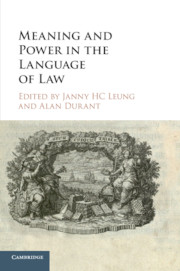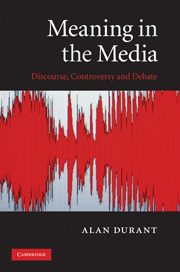48 results
Part II - Imperfect Fit between Legal Categories and Social Discourse
-
- Book:
- Meaning and Power in the Language of Law
- Published online:
- 28 December 2017
- Print publication:
- 18 January 2018, pp 93-134
-
- Chapter
- Export citation
Editors' Introduction
-
-
- Book:
- Meaning and Power in the Language of Law
- Published online:
- 28 December 2017
- Print publication:
- 18 January 2018, pp 1-16
-
- Chapter
- Export citation
Contributors
-
- Book:
- Meaning and Power in the Language of Law
- Published online:
- 28 December 2017
- Print publication:
- 18 January 2018, pp vii-xii
-
- Chapter
- Export citation
Afterword
-
- Book:
- Meaning and Power in the Language of Law
- Published online:
- 28 December 2017
- Print publication:
- 18 January 2018, pp 303-319
-
- Chapter
- Export citation
Part III - Written in Silence: Hidden Social Meanings in Legal Discourse
-
- Book:
- Meaning and Power in the Language of Law
- Published online:
- 28 December 2017
- Print publication:
- 18 January 2018, pp 135-204
-
- Chapter
- Export citation
Part IV - Conflict between Linguistic and Legal Ideologies
-
- Book:
- Meaning and Power in the Language of Law
- Published online:
- 28 December 2017
- Print publication:
- 18 January 2018, pp 205-256
-
- Chapter
- Export citation
Contents
-
- Book:
- Meaning and Power in the Language of Law
- Published online:
- 28 December 2017
- Print publication:
- 18 January 2018, pp v-vi
-
- Chapter
- Export citation
Copyright page
-
- Book:
- Meaning and Power in the Language of Law
- Published online:
- 28 December 2017
- Print publication:
- 18 January 2018, pp iv-iv
-
- Chapter
- Export citation
2 - Seeing Sense: The Complexity of Key Words That Tell Us What Law Is
- from Part I - Sui generis or Socially Problematic: The Character of Legal Language
-
-
- Book:
- Meaning and Power in the Language of Law
- Published online:
- 28 December 2017
- Print publication:
- 18 January 2018, pp 32-70
-
- Chapter
- Export citation
Part I - Sui generis or Socially Problematic: The Character of Legal Language
-
- Book:
- Meaning and Power in the Language of Law
- Published online:
- 28 December 2017
- Print publication:
- 18 January 2018, pp 17-92
-
- Chapter
- Export citation
Part V - Demands of Law and Limits of Language
-
- Book:
- Meaning and Power in the Language of Law
- Published online:
- 28 December 2017
- Print publication:
- 18 January 2018, pp 257-302
-
- Chapter
- Export citation
Acknowledgements
-
- Book:
- Meaning and Power in the Language of Law
- Published online:
- 28 December 2017
- Print publication:
- 18 January 2018, pp xiii-xiv
-
- Chapter
- Export citation
Index
-
- Book:
- Meaning and Power in the Language of Law
- Published online:
- 28 December 2017
- Print publication:
- 18 January 2018, pp 320-330
-
- Chapter
- Export citation

Meaning and Power in the Language of Law
-
- Published online:
- 28 December 2017
- Print publication:
- 18 January 2018
33 - Media stylistics
- from Part V - Extensions of stylistics
-
-
- Book:
- The Cambridge Handbook of Stylistics
- Published online:
- 05 March 2015
- Print publication:
- 08 May 2014, pp 503-519
-
- Chapter
- Export citation
Contributors
-
-
- Book:
- The Cambridge Handbook of Stylistics
- Published online:
- 05 March 2015
- Print publication:
- 08 May 2014, pp ix-xv
-
- Chapter
- Export citation
8 - ‘Substantial similarity of expression’ in copyright infringement actions: a linguistic perspective
- from Part V - Linguistics
-
-
- Book:
- Copyright and Piracy
- Published online:
- 17 November 2010
- Print publication:
- 28 October 2010, pp 147-193
-
- Chapter
- Export citation
Index
-
- Book:
- Meaning in the Media
- Published online:
- 05 June 2012
- Print publication:
- 04 March 2010, pp 250-254
-
- Chapter
- Export citation
Part II - Making sense of ‘meaning’
-
- Book:
- Meaning in the Media
- Published online:
- 05 June 2012
- Print publication:
- 04 March 2010, pp 65-66
-
- Chapter
- Export citation

Meaning in the Media
- Discourse, Controversy and Debate
-
- Published online:
- 05 June 2012
- Print publication:
- 04 March 2010



